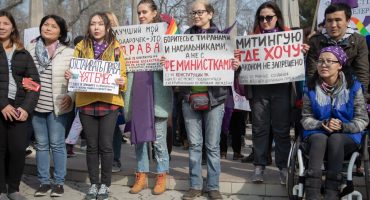How should journalists report natural disasters, terrorist attacks, personal crimes and suicides in an ethical and professional manner?
The CABAR.asia media school has collected the most important recommendations here.
Hasty or incomplete reporting of events can cause collateral damage to people who unwittingly become subjects of news.
Check the facts. The accurate number of victims in a message is a priority task.
Also, keep asking yourself what will happen after your story is published? How will it affect the lives of the people you told about to the world?
The journalists, just like doctors, should do no harm.
The report must be compassionate. The journalist must keep in mind that people who become the contributors of reports about natural disasters, emergencies, and other tragedies, have relatives, friends, relatives and neighbours, for whom the people you tell about are not just contributors of reports.
Media workers must provide the public with true reports of disasters. However, ethics guidelines suggest that reporters should show compassion for those who may be affected adversely by news coverage.
It is absolutely necessary that journalists treat vulnerable contributors sensitively and with respect. No story is worth a person’s mental health or a person’s life, not journalist’s and not contributor’s either. Experienced journalists call it a privilege to share people’s pain. This should be never abused.
If you need to interview a victim of tragic events or their relatives, keep in mind that they all suffer – it’s a very traumatic experience. Don’t be too persistent, don’t aggravate their emotional state.
Also, there is no universal approach to working with people’s reactions and emotions. However, there are good practices, which reporters can adapt to themselves to do their job without harm.
Avoid sensational and short-termist media coverage, which exhausts audiences in its relentless and unending parade of death and horror.
The drive to break news immediately puts pressure on journalists to balance impactful reporting with ethical concerns, and to consider the emotional vulnerability of their subjects and their audience, avoiding sensationalism. One possible solution is that journalists perform more emotional labour, abandoning the posture of impartiality in favour of that of a compassionate witness. Journalists could employ a mindfulness approach to help improve their work and minimise the suffering it might otherwise inflict upon themselves and others.
Sensationalised stories of looting during emergency can turn needed attention away from emergency relief and response and toward calls for vigilante behaviour or martial law.
Misreporting and misrepresentations also muddle the ways in which disasters lay open inequities in communities. Television images of burning celebrity mansions do not convey to audiences that wealthy citizens are able to recover from devastating loss far more quickly than the average resident.
Explain what has caused the disaster. It could be poor building codes, underinvestment in preparedness, and so on.
There’s a compelling story behind every disaster that needs to be reported on as part of understanding a crisis. Explaining causes can help people to understand why a disaster occurred and what might be done to prevent another in the future.
The myths that disasters lead to anarchy or looting, or that they bring out the worst in people are well-documented.
However, the reality is often the opposite of these myths. Instead of looting, people sometimes come together and support each other. Instead of anarchy, sometimes new forms of organising arise.
Myth reporting also can lead to a situation when people finding themselves in a crisis situation wouldn’t be even helped by charities.
A disaster story does not always end when smoke disappears, or floodwaters retreat. If infrastructure is destroyed, a disaster might continue. Recovery processes can be long and unfold weeks, months and even decades after a hazard strikes.
In some cases, individuals and communities never truly recover – instead the traumas they suffer can manifest in mental and physical health problems that are passed down over generations.
Covering the period after the hazard hits can help capture a fuller story.
When reporting such cases, try to adhere to the following rules:
- Don’t describe the method and location of the suicide, don’t publish photos and videos from the scene;
- Avoid describing details of a suicide note, just report that a note was found;
- Don’t describe intimate details about the person who died or attempted suicide, keep information general;
- Report that coping skills, support, and treatment work for most people who have thought about suicide;
- Describe warning signs and risk factors, including mental illness, that give the suicide context;
- Don’t romanticise suicide, provide context and facts to counter perceptions that that suicide was tied to heroism, honour or loyalty to an individual or group.
Title photo: Consequences of the explosion of an ammunition depot in Arys, Kazakhstan. RFE/RL
This publication was produced as part of the mentorship programme under the Development of New Media and Digital Journalism in Central Asia project delivered by the Institute for War and Peace Reporting (IWPR) with support from the UK Government. It does not necessarily reflect the official views of IWPR or the UK Government
If you have found a spelling error, please, notify us by selecting that text and pressing Ctrl+Enter.





